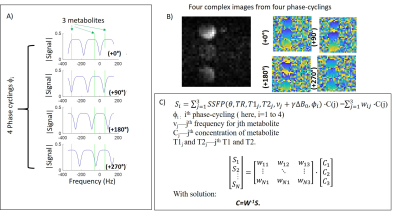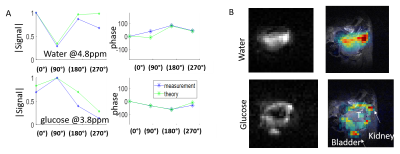Dana C. Peters1, Stefan Markovic2, Qingjia Bao2, Dina Preise2, Keren Sasson2, Lilach Agemy2, Avigdor Scherz2, and Lucio Frydman2
1Radiology and Biomed Eng., Yale University, New Haven, CT, United States, 2Weizmann Institute of Science, Rehovot, Israel
1Radiology and Biomed Eng., Yale University, New Haven, CT, United States, 2Weizmann Institute of Science, Rehovot, Israel
Linear combination bSSFP is useful for deuterium metabolic imaging.

Figure
1:
A) Plot of the modulus of SSFP’s signal vs. frequency offset under the four phase-cyclings, shifting the “banding“
pattern as indicated for TR=5.7ms. Also shown are the frequencies expected for
deuterated lactate, glucose and water (green lines) at the utilized field. B) 2H
MRI acquisition of bSSFP images with multiple phase-cyclings on a
three-metabolite phantom. C) The images can be analyzed as a sum of complex signals (shown in A) arising from each metabolite, based on the phase-cycling; the contribution of
each metabolite is then determined by matrix inversion.

Figure 5: LC-SSFP of
deuterated water and glucose in a pancreatic cancer tumor, 30 minutes after
injection of deuterated glucose (i.e, before the generation of substantial 2H-lactate). A) Magnitude/phase signal evolutions of water
(top) and glucose (bottom), comparing measured values to predicted values. The TR was 5.7ms, and carrier offset 4.3ppm
(between glucose and water). B) Metabolites
separated using LC-SSFP’s theoretical weights.
T=tumor. Left: Raw 2H images. Right: 2H images
overlaid on 1H MRI anatomy.
